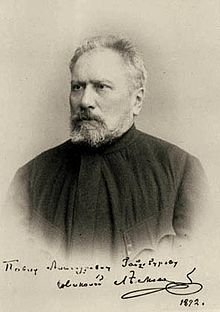Pavlin (Nikolai Leskow)
Pawlin ( Russian Павлин ) is a short story by the Russian writer Nikolai Leskov , which appeared in the Saint Petersburg magazine Niva in 1874 .
content
The hard-working, thrifty and extremely frugal Pavlin Petrow Pewunow from Tsarskoye Selo had successively ransomed himself and his family from serfdom . He worked for the narrator's 45-year-old Anna Lvovna, a wealthy aristocratic aunt, as a servant and caretaker in Petersburg.
Pawlin was now alone. The three relatives had all died of cholera . The caretaker, it seems, has no mercy if one of the tenants cannot pay. Even in the coldest winter, he then immediately has two assistants tear out the windows and frames in the apartment in question. Pawlin only follows the instructions of his strict mistress. For the widow Anna Lvovna, pity is a foreign word.
When the mother of the five-year-old aristocratic half-orphan Lyubov Andreevna, known as Lyuba, dies in one of these rented apartments, Pawlin takes the little penniless orphan with him and later finances her schooling as well as her professional training. As a 14-year-old Ljuba blossomed into beauty. Pawlin is 35 years older than the girl. As a noblewoman, Lyuba disdains the disdainful apprenticeship among seamstresses and seeks protection from the hard-hearted Anna Lvovna. Calculating what this woman is like, she chooses Lyuba as the executor for her son, the cornet Woldemar, called Dodja. Because Lyuba can't just live under the same roof with the adult Dodja, the self-serving Anna Lwowna persuades the 16-year-old girl to marry Pavlin. Lyuba avoids Pavlin wherever she can, avoiding him not because of his age, but because he is a lackey . Pawlin does all the housework for his wife and gives her his savings. Because Dodja, a simple-minded drip, throws money at masked balls and similar amusements, lets himself be taken advantage of by reckless women and ends up running into debt. Lyuba loves Dodja and cheats on Pavlin; becomes pregnant by Dodja. Dodja is taken into custody by the police. His cavalry regiment solves the problem. Dodja is banished behind the Urals . Lyuba follows him to Siberia . Pawlin quits the service, pursues the couple and forces Dodja, a Petersburg bon vivant, who is unwilling to marry, to marry Lyuba. Pawlin had previously had himself declared dead and obtained a passport in the name of Spiridon Androsov. Dodja can't stop gambling and dies in Siberia after a tavern fight. Then Ljuba goes into a convent on Dnepr -Ufer. Pawlin becomes a monk in Valaam Monastery .
reception
- 1959: According to Setschkareff, Pawlin's character was drawn plausibly, whereas Ljubas, that is, her transformation from “empty, pleasure-addicted gosling into ascetic”, had failed. Thematically speaking, Leskov polemicizes Chernyshevsky's novel What to do? from 1863.
- 1969: Reissner observes that the figure of the honest petty-bourgeois Pawlin also lives off the contrast to the noble failure Dodja.
- 1985: Dieckmann remarks that Leskow thematizes the greed of the haves, which arose in the second half of the 19th century in the Russian metropolis. Pawlin is portrayed in this process on his way from compliant executor to victim.
filming
Based on the novella, the feature film drama Tragedy of a Passion was released in 1949 . The screenplay was written by Emil Burri , the direction was taken over by Kurt Meisel .
literature
German-language editions
- Pawlin. German by Hartmut Herboth. P. 526–601 in Eberhard Dieckmann (Ed.): Nikolai Leskow: Collected works in individual volumes. Vol. 3. The sealed angel. Stories and a novel. 795 pages. Rütten & Loening, Berlin 1985 (1st edition)
Output used:
- Pawlin. German by Hartmut Herboth. P. 85–163 in Eberhard Reissner (Ed.): Nikolai Leskow: Collected works in individual volumes. The enchanted pilgrim. 771 pages. Rütten & Loening, Berlin 1969 (1st edition)
Secondary literature
- Vsevolod Sechkareff : NS Leskov. His life and his work. 170 pages. Verlag Otto Harrassowitz, Wiesbaden 1959
Web links
- The text
- Entry in the Laboratory of Fantastics (Russian)
- Entries in WorldCat
